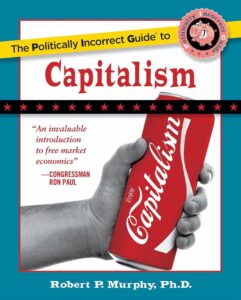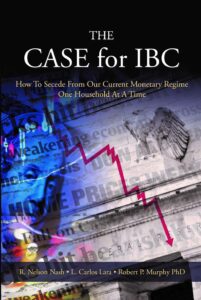Scott Sumner Says What We’ve Been Waiting For
He’s been tip-toeing around it for over a year, but this is the clearest expression I’ve yet seen:
“Monetary policy is the Achilles Heel of free market economics.”
Now you might be thinking, “Exactly! I can’t stand all these ‘free market’ economists who think the one good the market can’t produce is money. They’ll talk your ear off about the wonders of supply and demand, and the dangers and absurdities of central planning, except when it comes to the money. In that case, the market is idiotic and leads to a decade-long slump like a turtle on its back, and central planners can save the day–so long as they read the right blogs.”
Except, of course, that’s not what Scott has in mind.
I keep crawling back to Scott’s blog, and then he keeps breaking my heart. When will I learn that he’s just no good for me?
It’s Getting Closer…
Remember the Night of Clarity event is on Friday, July 16, and the follow-up workshop on the connection between Austrian economics and the Infinite Banking Concept is on Saturday July 17. We know of 100 people who are coming for sure, but the room we rented can hold a lot more.
On the fence? Check out the cool collage.
Naomi Wolf Doing Her Part
I was thrilled to see Lew Rockwell post another interview with Naomi Wolf. (In their last one, you could see it finally dawn on her why “right wingers” might oppose government control of education besides them hating literacy and/or minority children). In this interview, Wolf says she is moving from being a progressive to a libertarian, and she calls the American empire “satanic” (!!).
Check out the trailer for her new movie:
The End Of America from IndiePix on Vimeo.
A Challenge for the Free Bankers
I was reading Mises’ discussion of the trade cycle in Human Action (the Scholar’s Edition, if it matters). I am sorry but it seemed to 100% confirm Salerno’s position in the recent spat. (I’m not going to bother hyperlinking; if you don’t know what I’m talking about, I envy you.)
Now don’t get me wrong, White, Horwitz, et al. could still say that Mises’ writings in this section of Human Action are consistent with their position, but prima facie he seems to be saying exactly what Salerno attributes to Mises.
So my question is this: Are there any passages in Human Action that would prove uncomfortable to Salerno? In particular, are there any passages where Mises says that the issue of fiduciary media–within the limits that would exist under free banking, perhaps–could have positive effects? I saw not a word of this in the sections directly treating the trade cycle. There, Mises unambiguously said that any expansion of fiduciary media caused the trade cycle.
(However, he seemed to be assuming an initial equilibrium. So the loophole White and Horwitz could claim is that Mises just didn’t deal with the situation in which there is an increase in the demand for money, which is exactly counterbalanced by the issue of new fiduciary media.
To say it one more time in different words, what I am now asking is if there is any place in Human Action where Mises positively affirms the view of White and Horwitz?
And by the way, please don’t point to Mises’ support of free banking and his insistence that government prohibitions on FRB are unnecessary. That per se means nothing. There are several passages where Mises clearly says that issuing fiduciary media period causes the trade cycle, so he presumably thinks that it’s a dinky little trade cycle when the fiduciary media issuance isn’t backed up by the government. Indeed, he literally says this in the sections I read today.
So what say you, kids? Can you find a passage in Human Action where Mises clearly says that a world of no fiduciary media is worse than a world with the fiduciary media that would occur under free banking?)
US Army Cracks Down on Murphy in Haiti
OK sorry for the sensationalist headline… In response to my Mises Daily on Haiti, I got the following message from an officer in the U.S. Army (reprinted with permission):
Robert, I read your article in Christian Science Monitor titled “Economic Lessons from Haiti”. I have a few comments for you with regards to your observations under the Building Codes section. To introduce myself, I am an engineer officer in the U.S. Army. I am the project manager for a number of construction projects throughout the country. All my projects are built by local labor, not Army engineer units. Also, all my projects are engineered and rated to withstand both earthquakes and hurricanes.
First, Haiti has no building code. Jamaica and France have both offered theirs for Haiti to accept it and ratify it as their own. With no national building code, there is no standard to build to. Second, Haiti does have a practical building permit system. A residential building permit costs $640 USD. The average daily wage of the few that are employed is $5.26 USD. With such a meager wage, few if any are willing to dole out $640 to get a building permit and have their home inspected during the construction process.
Another major issue is the quality of materials. The U.S. standard for the stregth of a CMU (concrete masonry unit AKA cinder block) is 1900 psi. The large manufacturers in Haiti know how to build a proper CMU. The problem is that, surprisingly, they can’t obtain sand which is a main ingredient in concrete mixes. They’re substituting limestone, which is readily available and far inferior to sand. Not only does limestone have less strength than sand, limestone will literally eat away at the rebar which is put in the buildings to reinforce it. There are places where sand can be obtained, but few have made an investment to set up a crushing plant and haul road to transport this vital raw material to the concrete plants. Right now, they have numerous mining operations set up to quarry their limestone. If such operations were set up to produce sand, the cost for raw materials would be the same, hence the cost of the CMU block would be the same but with a much stronger block. In addition, we have identified CMU manufacturers that cut corners to save costs. They don’t add the right amount of cement into the mix. This is done purely to save costs to the plant owner. Well, the problem is that less cement in the mix means a weaker CMU block. They’re not offering a reduced price for this inferior block. They’re charging the same and the public is being duped.
Rebar is also problematic here. Rebar gives a structure it’s tensile strength (the ability for beams to stay together). The problem is that rusty rebar loses its strength. Haitians don’t understand the importance of keeping rebar out of the rain and elements until it is installed. They habitually install rusty rebar in buildings. Rust-covered rebar embedded in a limestone concrete mixture can literally dissolve in about 2-3 years thus negating any strength properties the steel would initially have given to the structure. In essence, they’re pretty much wasting their money by installing rusty rebar in inferior concrete mixes. In addition, they do not know how to specify what size rebar to use for each application. I constantly see rebar that is for example 1/4″ diameter but 1/2″ diameter steel should have been used. This wasn’t done for cost purposes; they just didn’t know better. Also, they don’t know how to join rebar splices together. Rebar loses it’s strength if the joints aren’t correctly spliced.
Haitians do not understand how to lay CMU blocks. They use the wrong mixes for their mortar, they don’t mortar their joints properly, they habitually use broken block thinking it’s the same as an unbroken block, etc. When they pour concrete, they don’t understand the importance of vibrating the concrete mix to remove the air voids. This creates what is known as a honeycomb effect. This creates a massive weak plane in concrete and usually a point of failure. Also, Haitians NEVER install expansion joints or control joints. All structures naturally contract and expand with air temperature due to thermal properties. You need joints in a building to permit proper expansion to prevent the building from cracking. You also need these joints installed for seismic reasons to make the structure more “flexible”.
Finally, Haitians don’t use crushed rock in their concrete mixes. A rock crusher is needed to crush rock. They use river rock in everything. River rock is smooth and slick. Cement can’t bind to it. It’s like trying to pour a bag of cement on some marbles- it’s not going to stick very well. Yes, a rock crusher is an investment. There are a few out here, but there are too few to support the needs of the construction industry here.
In summation, it was the shoddy workmanhip and subpar materials that killed the people. A quality structure that is safe and engineered to resist both earthquakes and hurricanes can be designed and built in Haiti. The factors that need to change are substandard building materials, poor workmanship, an lack of engineering. The only component that would increase the cost of a building is the engineering. This cost could be negligible if some engineers were to mass-produce a set of floor plans that could be purchased for a few dollars similar to the ones we can buy in the U.S. through those house plan books.
As I said in the beginning, I’m building over 40 projects throughout the country. These projects are using local labor and local building materials, yet they will be hurricane and earthquake safe. The difference is that my projects are designed by an engineer and a competent project manager is running the projects to ensure proper workmanship and good quality materials are used. Aside from the engineering, my pro forma budget is the same as what any other Haitian contractor would spend to build the same projects.
Bernanke Calls to End the Fed! He Endorses ABCT!!
OK not quite, but I am not making up this quotation:
US FEDERAL Reserve chairman Ben Bernanke has warned against government interference in monetary-policy setting, saying it contributes to boom-bust cycles and inflation risks.
“Political interference in monetary policy can generate undesirable boom-bust cycles that ultimately lead to both a less stable economy and higher inflation,” Mr Bernanke told a central bankers’ conference in Tokyo today.
Mr Bernanke registered strong concern about political pressure for central banks to increase their public sector bond-buying programs to help soak up government debt – potentially a major issue for the US, euro-zone and Japanese economic managers as they grapple with fiscal consequences of massive public stimulus programs over the past 18 months.
“Abuse by the government of the power to issue money as a means of financing its spending inevitably leads to high inflation and interest rates and a volatile economy,” he told the conference.
The article goes downhill from there.
For an analogy, I think it would be like Ron Paul calling to cut government funding for Halliburton, and then the Halliburton CEO testifying that politicians shouldn’t meddle in such matters, because historically the military-industrial complex has spawned needless wars and countless deaths.
(Thanks to my online business class student, John Morgan, for the link. Speaking of the Mises Academy, have you seen the new course offerings? Get in front of this parade, kids. Everyone’s doing it.)
Role Model for White Boys
I am introducing a new category of blog posts that I hope I will not abuse. Sometimes I come across fairly random YouTube clips that are the perfect length–just long enough to make sure you don’t get back to work, but not long enough to scare you away from clicking Play.
Some economists might post a YouTube of John Nash. That’s not how we roll at Free Advice.
Scott Sumner Misses One Obvious Explanation
Scott has a theory for why world economic growth suddenly slowed in the early 1970s:
Here’s what I think happened. There were a few underlying technological developments in the late 19th century that dramatically affected living standards in the 1920-70 period, when they were widely adopted in advanced economies. I would certainly include electric power and the internal combustion engine. I also think indoor plumbing is underrated. Imagine having to rely on outhouses in cold climates. And also recall the health advantage of safe drinking water. And I suppose modern chemistry should be included—something I know little about. Many key products were first invented in the late 1800s or early 1900s (electric lights, home appliances, cars, airplanes, etc) and were widely adopted by about 1973. No matter how rich people get, they really don’t need 10 washing machines. One will usually do the job. So as consumer demand became saturated for many of these products, we had to push the technological frontier in different directions. And that has proved surprisingly difficult to do.
In a follow up post he stated it even more concisely: “In my last post I argued that the growth of the 1950s and 60s resulted from a technological revolution that began in the 19th century and hit a wall around 1973.”
Hmm, can we come up with something a bit more concrete? Was there any major institutional change that could conceivably affect world economic growth (and in particular US economic growth), that was true in the 19th century and then suddenly ended in the early 1970s?







Recent Comments